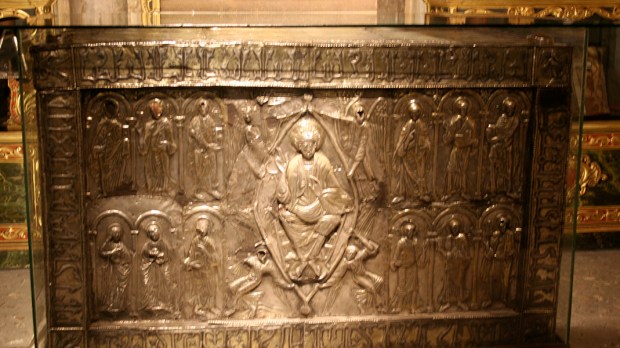The Shroud of Turin was in the news again recently. Newly released documents call into question the conclusion of a 1988 study that suggested that the burial shroud of Christ was a pious medieval “forgery,” according to one researcher.
An object that gets much less attention, though, is equally interesting. And for many believers, there is far less doubt surrounding the Sudarium of Oviedo, as it is known.
“It was preserved from the time of the crucifixion in a reliquary; however, the [Shroud and the Sudarium] were separated—eventually being carried to other countries,” blogger Kathy Schiffer writes in the National Catholic Register.
According to Schiffer, the Sudarium never went missing, so its location can be traced back to ancient times. It has been in the possession of the Knights Templar, the Moors, El Cid, saints and bishops. Since 631, it has been in Spain and since 840 in the cathedral of Oviedo in north-central Spain.
Before that it was, according to an account by Antoninus of Piacenza, hidden in a cave near the monastery of St. Mark, not far from Jerusalem. When Persian forces invaded the Byzantine provinces in 614, the oak case in which the Sudarium was kept was spirited out of Palestine through northern Africa by Philip “the Presbyter,” a leader of the Christian community in Palestine. Philip and his precious cargo were welcomed to Alexandria by John the Almoner, bishop of Alexandria at the time. When the Persians pushed on into Egypt, the chest was carried into Spain and entrusted to St. Fulgentius, who sent it on to Seville. The Ark was carried from Toledo north to Monte Sacro in Asturias in 711 A.D., to escape the advancing Moors. It was there that King Alfonso II turned back the Moors and erected a Camara Santa (holy chamber) to shelter the relics. King Alfonso had the ancient oak chest plated with silver with the inscription “The Sacred Sudarium of Our Lord Jesus Christ.”
Study of the Sudarium helps to authenticate the Shroud of Turin, Schiffer notes, because of notable similarities between the two cloths.
“Of prime importance, the blood and lymph stains on the two cloths match—both are type AB, which was uncommon among medieval Europeans but is a common blood type in the Middle East,” she says.
The material used in the two cloths is identical, although there are differences in the manner of weaving. Pollen residues on the Shroud and the Sudarium both provide evidence that the cloths were in the same region of Palestine. Stains on the two cloths would also seem to match. Because of the way the Sudarium would have covered the head, there is no clear face print—but there are remarkable correlations between stains on the two cloths. The Sudarium would have been wrapped over the head of Christ while his relatives waited for permission to remove the body; and so the stains show that the body was held in a vertical position with the head dropping back. At the back of the head, the cloth shows blood from deep puncture wounds, similar to the wounds on the Shroud of Turin, which may have been made by the crown of thorns. A second, overlaying stain was produced by fluids excreted from the nostrils when the body was lain horizontally. According to the Investigation Team from the Spanish Centre for Sindology, which has been studying the Sudarium since 1989, this second set of stains is composed of one part AB-type blood and six parts oedemal fluid. This fluid proves, according to scientists, that the victim died from asphyxiation—which is the cause of death for people who are crucified. Comparing the cloth to the Shroud of Turin, one researcher has identified 70 points of correlation on the front of the Sudarium and 50 on the back. Dr. Alan Whanger, professor emeritus from Duke University, used a Polarized Image Overlay Technique to demonstrate correlations between the two cloths.
The Sudarium is kept in the Arca Santa in the Oviedo cathedral (pictured). While the Shroud of Turin is brought out for public viewing only rarely, the Sudarium is displayed three times a year: Good Friday; September 14, the Feast of the Triumph of the Cross, and September 21, the octave of that feast.
Oviedo is about 80 miles north of the main pilgrimage trail for Santiago de Compostela.

